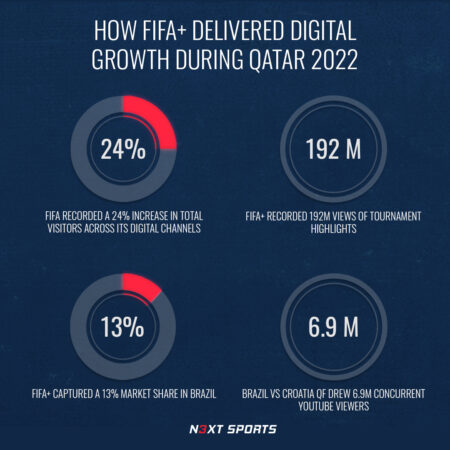Insights from Motasem El Bawab

When integrating new technologies and software solutions into an organization’s digital infrastructure, one challenge for sports properties is to scale their digital inventory and customer relationship management (CRM) capability without generating data silos. As cited in our 2023 Digital Trends in the Sports Industry report, data simplification is a key step towards achieving a harmonious flow of data between products/services, while data centralization requires a robust and reliable customer database which connects every digital touchpoint.
Digitalization is helping rights holders on multiple fronts, namely the adoption of user-facing digital products that help to increase direct-to-fan connection and engagement. However, digital transformation also serves the optimization of operational processes, where – by enhancing the employee experience (EX) – better data access fosters better decision making, workforce collaboration, and therefore an entity’s ability to innovate and deliver digital products/services that heighten the user experience (UX).
While, nowadays, there is an onus on direct-to-consumer (D2C) media and the role of mobile-supported, over-the-top (OTT) content production for widening an organization’s fan engagement, data ownership is also identified as a key factor for building and retaining audiences and is, in turn, one of the drivers for OTT adoption among federations and their regional stakeholders, in addition to generating and augmenting new revenue streams.
For example, the English Football Association’s (The FA) digital strategy included the rollout of The FA Player mobile-supported, subscription streaming service, which not only provides users with live and on-demand (VOD) video content from the organization’s domestic club and national team fixtures, but also acts a conduit for The FA’s ticketing and ecommerce servers.
This demonstrates how, by connecting an organization’s digital touchpoints via a single application, such as an owned OTT streaming service, the rights holder makes it easier to consolidate the collection and extraction of first-party user data via a single sign-on (SSO) or a unique user login. Therefore, while fan data can help rights holders to personalize digital fan experiences, how data serves the employee and internal decision making also requires a digital product portfolio that is optimized for data collection and tracking via a centralized database.
For example, whereas a marketing manager wants to identify the user journey via a customized marketing funnel dashboard, the technology and data team should also be able to access the data via the data lake itself. Therefore, considering the array of data demands across a sports organization, by integrating its digital services in a way that promotes cross-departmental data governance, the rights holder is able to enhance dataflow via a centralized touchpoint which serves both the user and employee experiences in tandem.
CASE STUDY | FIFA+ MORE THAN A VIDEO-STREAMING PRODUCT
When developing a unique content offering that enables the rights holder to widen its fan engagement capability in local and overseas markets, an OTT streaming product is conducive to capturing and updating audience data during its evolution; via a platform that supports the entire user journey, from the consumption of live matches to the purchase of tickets and merchandise and testing new digital experiences.
The launch of FIFA+, football’s global governing body’s dedicated OTT streaming service, acts as a benchmark for how direct-to-consumer (D2C) digital-product development is supporting the federation’s regional marketing efforts. For example, the digital platform played a central role in the organization’s fan engagement strategy in the Brazilian market during the Qatar 2022 men’s FIFA World Cup, with subscribers able to livestream all 64 tournament matches for free, produced in Portuguese and including local commentary.
The strategy offered an alternative to the governing body’s traditional broadcast partners in Brazil and saw FIFA+ draw 40 million unique visitors and capture a 13 percent viewership share in the region during Qatar 2022, according to the latest figures from FIFA. The personalization of content across FIFA’s multiple online services also helped drive a 24 percent increase in visiting fans to FIFA’s digital channels compared to Russia 2018, including 192 million views of Qatar 2022’s match highlights globally. For example, its local strategy saw Brazil’s quarter-final clash with Croatia draw 6.9 million concurrent viewers on YouTube, a world record for a livestream via the social video platform.
Whereas the Qatar 2022 men’s FIFA World Cup generated peak audience engagement and web traffic for the governing body, the job since the final between Argentina and France in December has been to continue momentum while retaining audiences, as well as to find ways to enhance the digital aptitude of the football ecosystem. For example, in January, the governing body announced the launch of FIFA Digital Skills, an educational program designed to develop the digital literacy of professionals in the global football community, powered by FIFA+.
“We want to continue to use FIFA+ as a platform to give the entire world of football a voice,” says Charlotte Burr, FIFA’s Director of Strategy, Digital and FIFA+. “The FIFA Digital Skills initiative will provide best practices from experts and organizations for the 211 member associations (MA) to develop their digital capabilities to appeal to future fans and, ultimately, grow football for all.”
WHAT’S N3XT?
As sports organizations seek ways to grow their fan base and capture audience data via their own digital products/services, albeit the highest industry standard, there is no need for rights holders at the beginning of their digital transformation journey to replicate the aforementioned models or to own a streaming function straightaway.
Whatever their fan engagement strategy, owning a reliable CRM system that connects every one of its digital touchpoints provides the groundwork for sports properties to begin to scale their digital product portfolio without generating data silos. The simplification of the data-collection pipeline is therefore the first, vital step for striking this balance, and will make it easier for rights holders to segment digital content strategies for retaining subscribers, and to eventually adapt and consolidate their digital product portfolio in response to consumer demands and technology trends.
“Investing only in user acquisition without fixing user retention is throwing money down the drain,” explains Motasem El Bawab, N3XT Sports Chief Information Officer (CIO). “Audience and customer retention must be a primary focus for sports properties. [This] can be achieved by sustaining customer satisfaction via a combination of best-in-class user experiences, including a state-of-the-art retention engine through active content management and personalized communications to each segment.
“This requires an easy-to-use segment-fan-relationship manager to help rights holders maintain customer relationships and to build segmented audiences to power their audience growth, and to provide additional targeted communications to their sponsors. Therefore, by optimizing the use of user data inside an organization, sports entities that draw on a centralized data source (also known as a “single source of truth”) will help to enhance the customer experience (CX) and provide alternative, data-informed solutions for their partners to target the digital user and the digital fan.”
Our team at N3XT Sports works tirelessly to develop and implement digital strategies across a multitude of sports properties at federation level, competition level, and club level. To learn more about how digital transformation can support the growth of your organization and optimize your technological infrastructure, fill out the form below and we’ll be in touch. Our goal is to drive the digitalization of the sports industry and our clients.





